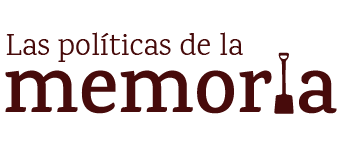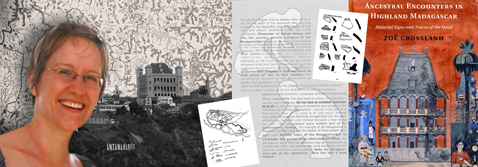Zoe Crossland
Zoe Crossland is an Assistant Professor at Columbia University. Her main theoretical interests lie in semiotic archaeology, and archaeologies of death and the body. She works in historical archaeology and the archaeology of the contemporary past, focusing particularly on nodes of controversy where conflicting sets of beliefs and practices converge. In particular, she is interested in the ways in which negotiations and conflict between actors are mediated through material conditions. To fully understand the extent to which archaeology may analyze such conditions, she works in two radically different areas of research.
Madagascar
Her research in Madagascar is concerned with archaeologies of encounter in the highlands. One aspect of this research traces the introduction of Protestant Christianity into Madagascar by British missionaries at the start of the 19th century. Here she focuses on the potential dislocation that was experienced when one way of living, learned through a lifetime’s experience within specific material and social conditions, was challenged in a confrontation with a radically different understanding of how to act effectively and morally, the ways in which people attempted to resolve and make sense of this dislocation, and the new and unanticipated formations that were created as a result. She is currently completing a book which explores the semiotics of encounters in highland Madagascar, provisionally entitled: “Encounters with Ancestors: archaeologies of recognition and loss in highland Madagascar”.
Forensic Archaeology and Charles Sanders Peirce’s Semeiotic
My second area of research focuses on the production of the excavated body. Here I draw on the semeiotic of C. S. Peirce to explore the signs of the body and of exhumation, considering how archaeologists constitute themselves and others through embodied material engagement with the world. Through exploring the language and orientation of forensic archaeology towards the excavation of human remains, this research works towards a fuller appreciation of the situated and material semiotic relationships through which archaeology is composed, in order to better understand how we construct meaning from excavated material remains.
Main publications:
Books:
- 2015. Disturbing Bodies: Anthropological Perspectives on Forensic Archaeology. Z. Crossland and R. Joyce (eds). SAR Press.
- 2014. Encounters with Ancestors in Highland Madagascar: Material Signs and Traces of the Dead. Cambridge University Press.
- 2012. A Fine and Private Place: The Archaeology of Death and Burial in Post-medieval Britain and Ireland, by A. Cherryson, Z. Crossland and S. Tarlow (co-authors). Leicester: University of Leicester Archaeological Monographs.
Articles:
- 2016 Meaning from Juxtaposition: A Conversation with Photographer Jon Crispin about the Willard Asylum Suitcases. Journal of Contemporary Archaeology 3.1: 103-120
- 2014 The Anthropocene: locating agency. Journal of Contemporary Archaeology. Forum on the Anthropocene 1(1):123-28
- 2013. Evidential regimes of forensic archaeology. Annual Review of Anthropology 42 (Theme: Evidence): 121-137.
- 2013. Signs of mission: material semeiosis and 19th century Tswana architecture. Signs and Society 1: 79-113.
- 2009. Of clues and signs: the dead body and its evidential traces. American Anthropologist 111(1):69-80.
- 2009. Acts of estrangement: the making of self and other through exhumation. Archaeological Dialogues 16(1):102-125.
- 2006. Landscape and mission in Madagascar and Wales in the early 19th century: ‘Sowing the seeds of knowledge’. Landscapes 7(1): 93-121.
- 2003. Towards an archaeology of ‘empty’ space: the efitra of the Middle West of Madagascar. Michigan Discussions in Anthropology, 14: 18-36.
- 2001. Time and the ancestors: landscape survey in the Andrantsay region of Madagascar. Antiquity 75(290): 825-836.
- 2000. Buried lives: forensic archaeology and Argentina’s disappeared. Archaeological Dialogues, 7(2): 146-159.
Chapters of books
- 2015. The signs of mission. Rethinking archaeologies of representation. In Materializing Colonial Encounters: Archaeologies of African Experience. François Richard (ed). New York: Springer.
- 2015. Epilogue: translating bodies. In Necropolitics. Mass Graves and Exhumations in the Age of Human Rights. Francisco Ferrándiz and Tony Robben, (eds). Philadelphia: University of Pennsylvania Press.
- 2015. Writing Forensic Anthropology; imagining the field in the US. In Disturbing Bodies: Anthropological Perspectives on Forensic Archaeology. Z. Crossland and R. Joyce (eds). SAR Press.
- 2011. The archaeology of contemporary conflict. In The Oxford Handbook of the Archaeology of Ritual and Religion. T. Insoll, (ed). Oxford University Press, 285-306.
- 2010. Materiality and embodiment. In The Oxford Handbook of Material Culture Studies (Ms No. 19). D. Hicks and M. Beaudry, (eds). Oxford University Press, 386-405.
- 2008. Z. Crossland, M. Freeman, P. Jones and B. Boyd. The Llanbadarn Fawr ‘gravestone urn’: an object history. In Monuments in the Landscape. P. Rainbird, (ed). Windgather Press, 212-227.
- 2002. Violent spaces: conflict over the reappearance of Argentina’s disappeared. In Matériel Culture. The Archaeology of Twentieth Century Conflict. J. Schofield, C. Beck, and W. G. Johnson, (eds), pp. 115-131. London: Routledge.



